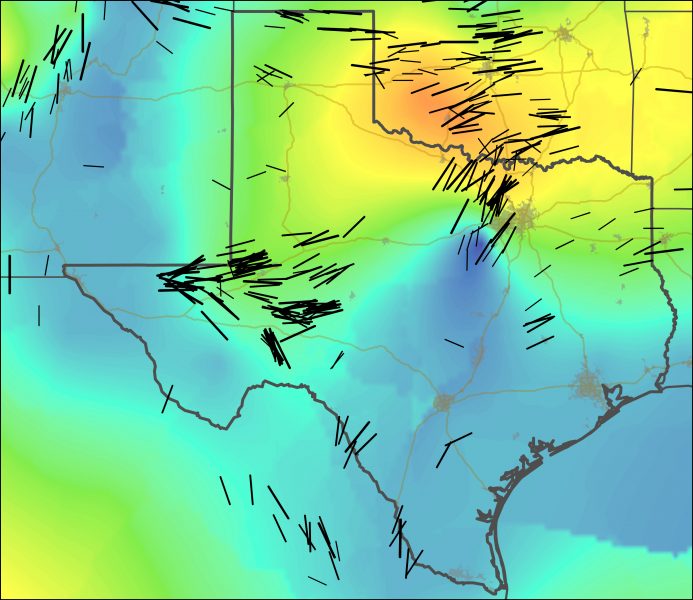Mark Zoback: Managing Wastewater Injection
November 20, 2017

Map of stress along faults in Texas and Oklahoma. Black lines indicate stress orientation. Blue-green colors indicate regions of extension in the crust, while yellow-orange areas are indicative of crustal compression.
In 2012, the U.S. Geological Survey reported that Oklahoma experienced 34 earthquakes. By 2015, the number increased to over 880, an increase largely attributed to the surge in wastewater injections following hydraulic fracturing, or fracking, operations.
Mark Zoback, professor of geophysics at Stanford University, gave a presentation at the Bureau of Economic Geology in June about the connection between earthquakes in Oklahoma and wastewater injection sites.
The talk centered on research published in ScienceAdvances in June
2015 that linked earthquakes to wastewater injection sites. Using a
new statistical model developed by Zoback and Stanford postdoctoral
fellow Cornelius Langenbruch, the researchers predicted that high
magnitude earthquakes will decline significantly if Oklahoma reduces
wastewater injection.

“Our model allows us to forecast the rate of potentially damaging earthquakes associated with water injection in north-central Oklahoma and parts of Kansas in response to reduced injection rates,” Zoback said.
The physics-based model relies on information about pore space, stress state and fault orientation. Wastewater collected during hydraulic fracturing, a process that injects water and chemicals into the earth to extract oil or gas, is disposed of in deep wells at high pressure. According to Zoback, billions of tons of wastewater are injected into deep layers of the Arbuckle formation and the underlying crystalline formation in Oklahoma. He said this pressure causes the fault slip that produces earthquakes.
Zoback added that earthquakes often occur on permeable, preexisting faults.
“Potentially active faults extend from the crystalline basement up to the Arbuckle,” Zoback said. “The pressure in the Arbuckle was really small, but it’s so permeable that the pressure spreads out and finds a critically stressed fault, called an active fault … which allows a pressure change at this depth to trigger seismicity.”
Zoback and his team modeled potentially active faults by assessing whether the injection increases pore pressure in the rocks. Also, fault orientation, or the angle and compass direction of the fault relative to the ground, factors into fault slip probability.
“Fault orientation is very important,” Zoback said. “In general, few preexisting faults are likely to be problematic. They [preexisting faults] are either too perpendicular to the fault and have too much normal stress to slip, or are too parallel and have too little shear stress to slip.”
Zoback and his team concluded that all relatively large recent earthquakes in Oklahoma occurred on “predictable” faults, or those that show evidence for vulnerability to earthquakes. But the great majority of earthquakes do not occur on mapped faults.
This data can be used to predict future earthquakes, Zobacksaid, but cautioned that even with their exceptional stress data,there are many unknown fault sites.
“The important thing is not only identifying potentially problematic
faults but identifying faults that aren’t problematic,” Zoback said. “But the weakness is, we don’t know about the number of faults … so only half the problem is solved. We know there are a lot more faults but they are just not on the maps.”
Despite some uncertainties, the study results spurred a recent decision by the Oklahoma Geological Survey to issue a statement that recognized injection of wastewater into wells, specifically in the Arbuckle formation, as the cause of the state’s recent earthquakes.
In 2016, regulators in Oklahoma mandated a 40 percent reduction of wastewater volumes, which Zoback said contributed to the reduction in earthquakes.
“We forecast that the probability an earthquake will exceed a magnitude of 4.5 in 2017 is 70 percent,” Zoback said.
“These high probabilities are basically cut in half from years ago, since injections have decreased.”
The work of Zoback and his team has pushed regulators to acknowledge the source of the recent earthquakes in Oklahoma, but hydraulic fracturing and wastewater disposal continues in the area.
Potential solutions to induced seismicity include completely halting injection of produced water into the Arbuckle formation entirely. Rather, Zoback suggests injecting the waste back into producing formations such as the Mississippian Lime, a limestone layer where much of the produced water in Oklahoma originates.
Zoback said his team also plans to continue developing a Texas stress map as hydraulic fracturing operations continue to increase in the state.
“They [oil companies] are still injecting, and our model shows that, at least in respect to magnitude five earthquakes, we are still on track,” Zoback said. “We are going to know in the next few years how the model is holding up. The problem, while not solved, is at least getting better.”
Back to the Newsletter